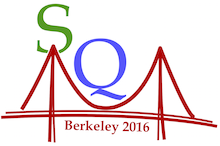Speaker
Roy Lacey
(Stony Brook University)
Description
The pseudorapidity density ($dN_\mathrm{ch}/d\eta$) for p($\bar{\mathrm{p}}$)+p, p+A and A+A(B) collisions, and the mean multiplicity $\langle N_\mathrm{ch}\rangle$ for $\mathrm{e^- + e^+}$, $\mathrm{e^{\pm}+p}$, and p($\bar{\mathrm{p}}$)+p collisions, are studied for an inclusive range of beam energies ($\sqrt{s}$). Characteristic scaling patterns are observed for both $dN_\mathrm{ch}/d\eta$ and $\langle N_\mathrm{ch} \rangle$, consistent with a thermal particle production mechanism for
the bulk of the soft particles produced in all of these systems. They also validate an essential role for quark participants in these collisions. The scaled values for $dN_\mathrm{ch}/d\eta$ and $\langle N_\mathrm{ch} \rangle$ are observed to factorize into contributions which depend on $\sqrt{s}$ and the number of nucleon or quark participant pairs $N_\mathrm{pp}$. Quantification of these contributions give expressions which serve to systematize $dN_\mathrm{ch}/d\eta$ and $\langle N_\mathrm{ch} \rangle$ measurements spanning nearly four orders of magnitude in $\sqrt{s}$, and to predict their values as a function of $\sqrt{s}$ and $N_\mathrm{pp}$. Several implications for these empirical scaling observations will also be discussed.
| On behalf of collaboration: | [Other] |
|---|
Author
Roy Lacey
(Stony Brook University)
